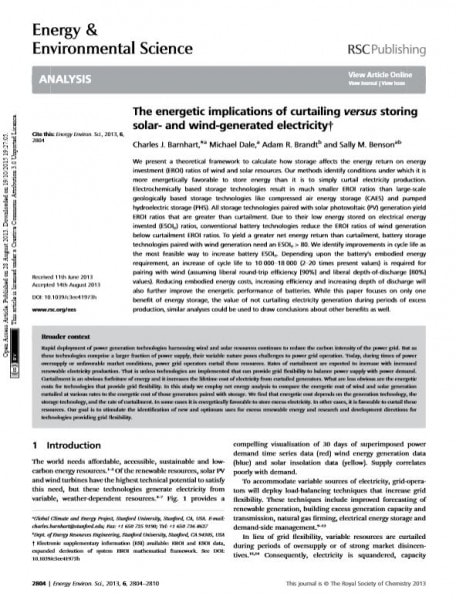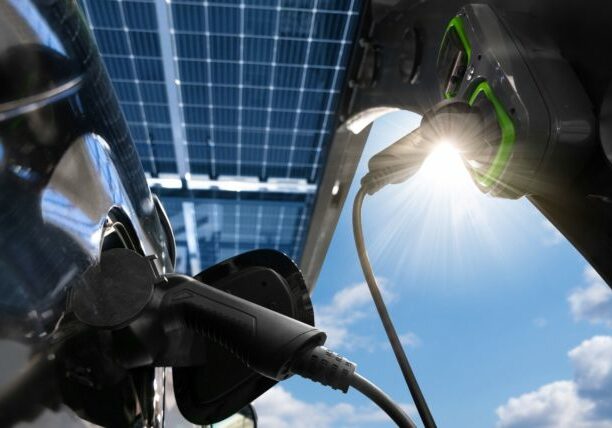October 10, 2013
Battery Storage and Wind Energy: The Stanford Study
By Todd Olinsky-Paul

Unfortunately, many of those headlines were misleading or just plain wrong.
For example, CleanTechnica’s report on the study came under the heading, “Study: Battery Energy Storage Benefits Solar, Not Wind.” The Energy Collective ran the story under the similar headline, “Study: Battery Energy Storage Works for Solar but Not Wind.” IEEE Spectrum used the headline, “Storing Energy from Solar and Wind Isn’t Always the Best Idea.” And Gizmag ran the story under the headline, “Scientists Challenge Economics of Storing Renewable Energy.”
A closer look at the Stanford study shows that there’s less going on here than meets the eye.
The study is titled “The Energetic Implications of Curtailing Versus Storing Solar- and Wind-Generated Electricity.” Like most scientific studies, it focuses on a very narrow and well-defined question: how does the addition of battery storage affect the energy return on energy investment (EROI) ratios of wind and solar resources? In other words, if you add a battery to a wind or solar generation facility, does the battery save as much potential energy (that would otherwise have been curtailed, or not produced, due to lack of demand or transmission capacity) as was required to manufacture and deploy the battery in the first place?
After doing a life-cycle analysis of the battery types in current use, and analyzing the amount of wind and solar energy such a battery could save from curtailment, the study’s authors conclude that pairing batteries with solar generation generally saves more energy than is required to produce the battery; however, in the case of wind generation, more energy is often required to produce the battery than is saved during periods of excess production. Therefore, a simple EROI calculation indicates that it makes sense to pair current battery technology with solar, but not with wind.
This is a good thing to know. But an EROI calculation alone is not a good basis on which to make policy or investment decisions. Energy storage can provide many services and benefits, beyond simply storing electricity for later use that would otherwise have been wasted. For example, it can provide resiliency benefits, keeping local portions of the grid energized when generators fail or storms knock out transmission lines; make more electricity available at times of high demand; defer or obviate the need for upgrades in transmission and distribution equipment; provide ancillary services to the grid; and smooth the output of intermittent resources, benefiting grid operations and reducing the need for fast ramping of dispatchable resources. To ignore all these benefits in favor of a simple energy in/energy out equation is to focus on an extremely narrow slice of the energy storage benefits pie.
In fact, the authors of the Stanford study go out of their way to point out the many benefits of energy storage that are not considered in this study. They state,
It is important that the netenergy framework presented here is used appropriately and that our results do not lead to simplistic or wrong conclusions. The value of available energy depends on time, location and need. The economic value of storing energy depends on many factors including extant policies, market forces, and power grid generation availability and power demand conditions…. the framework cannot adequately draw conclusions regarding the economic costs and benefits of storage in a given context…. We have focused on only one measure of the value of storage. It is equally important to consider other benefits provided by storage. (Energy Environ. Sci., 2013, 6, 2809)
In other words, this study tells you one thing only: that given the authors’ assumptions about battery cycle life and patterns of generation from intermittent renewable resources, pairing a battery with a wind farm may require more energy invested than will be saved over the life of the battery. The study says nothing about the many other services the battery could provide. Moreover, battery technology is advancing rapidly, meaning that by the time policymakers get around to adjusting incentive structures to reflect this study, the underlying calculations will almost certainly have changed.
So, does it make sense to use batteries at wind farms? Well, that depends on lots of variables, and the EROI is only one of them. Ultimately, the answer must be decided taking into account the specific location, technology, economics and resources involved; just as the answer to the question, “should we build another gas station on Main Street?” depends on many factors – not merely a calculation about whether the proposed gas station would distribute as much energy, in the form of gasoline, over its lifetime as was required to build, operate and maintain it.














